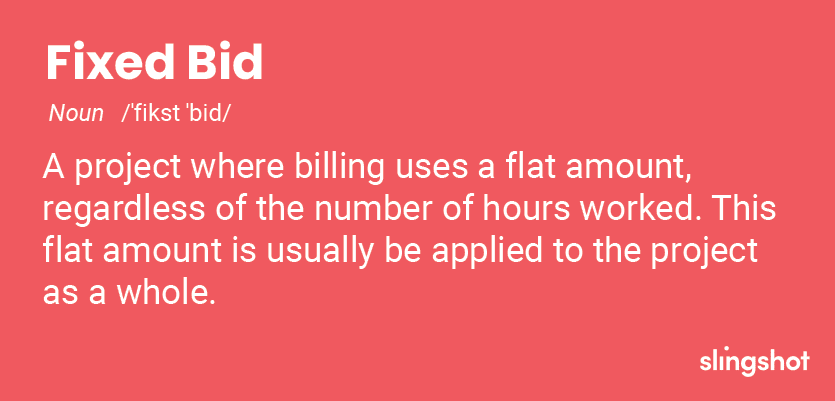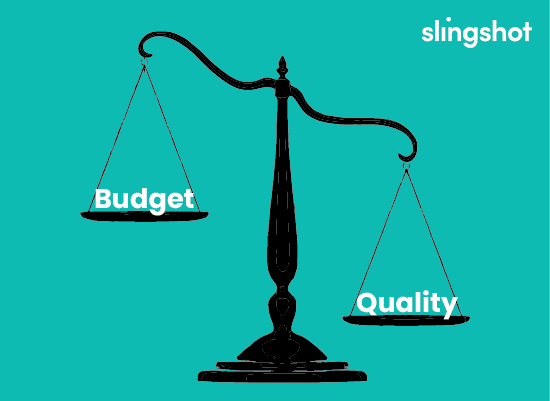Trying to get an accurate estimate before starting a tech product is like trying to find a needle in a haystack: it’s a challenging and time-consuming process that’s practically impossible to get exactly right.
But if you want tech work done, you need to know what you’ll be spending before jumping in. The good news is there are loads of ways to estimate a product, all with their own reasons why they’re the most accurate. One that we’ll be tackling today is fixed bids.
Trying to get an accurate estimate before starting a tech product is like trying to find a needle in a haystack: it’s a challenging and time-consuming process that’s practically impossible to get exactly right.
But if you want tech work done, you need to know what you’ll be spending before jumping in. The good news is there are loads of ways to estimate a product, all with their own reasons why they’re the most accurate. One that we’ll be tackling today is fixed bids.
In this blog, we’ll explore what fixed bids are, how they work, and why they may not be the best fit for your next project. But don’t worry, we’ll also look at another option that could be better for your project. avoid the pitfalls of fixed bids. So, let’s get started and find out what’s a fixed bid, exactly.
Summary
- Fixed bids give you one number upfront for what the expected cost is going to be, and that assumption is that that will be the entire project’s cost.
- The downsides of fixed bids include unpredictability, buffer costs, rigidity, and quality compromise.
- Time and Materials estimates charge based on the actual time and materials used during the development process
- The T&M model provides flexibility, transparency, and quality focus.
What’s a Fixed Bid, exactly?
Great question! When you ask a development team to build a product for you, there are loads of different ways they can estimate it. One option is a fixed bid: a flat fee that covers everything that could be needed for your project.
Unlike other options, a fixed bid will not come with a range: you simply get the expected cost from the dev team, and you pay that price with the expectation that the project will not go over said price.

The Downside of Fixed Bids
So TLDR for fixed bids: you get a specific price, and you pay that price. Seems efficient, right? Well, if it were that easy, we wouldn’t be writing this blog. Let’s take a look at some of the downsides of fixed bids.
Unpredictable
If you’ve ever been even near a development project, you know it very rarely goes according to plan. With the complexity of a product, you usually don’t really know what you’re getting into until you’ve started. That makes it extremely difficult to estimate what a project will cost before jumping in.
Fixed bids work best when you know exactly what you need to build, which doesn’t happen often. And if something comes up that wasn’t accounted for, you’re either going to be paying more or getting a lower-quality product than expected.
Buffer
With the risk of underestimating a fixed bid project, most companies will add a buffer to ensure they can account for any bumps in the road. While this means you’ll be less likely to pay more down the road, you may end up paying more than you needed to. That’s because if the buffer doesn’t end up being used, you still pay for it. Meaning you may be using a portion of your budget to pay for… well, nothing!
Rigidity
The requirements list you walk into a project with is usually very different than the one you end up with. Once you’re ‘under the hood,’ you’ll realize there are features you need that you hadn’t thought of yet.
Fixed bids don’t allow for that, since the estimate is based on what you needed before you started. Without the ability to pivot, you may end up with a product that doesn’t meet the needs of your users. Once again, you’re looking at additional costs than originally planned, rushed work to stay under budget, or a final product that won’t be successful. Yikes!
Quality Compromise
You may have noticed that a lot of the points above mentioned two options for what can be done: either the overall project cost is increased or the final-product quality decreases. Let’s talk about the latter; this doesn’t mean that the entire product will be low quality. If a team is getting close to the end of a project and realize they’re going to go over budget, chances are they’ll cut corners at the finish line to stay under.

While you’ll still be getting a product for the originally planned price, that product may have issues now thanks to the quality compromise. What if it wasn’t fully tested before launch? What if there’s a security flaw they missed? If your final product ends up being prone to bugs or other issues, you may end up with dissatisfied customers and lost business.
An Alternative: Time and Materials
So how do you avoid all these things, while still getting a good estimate? Don’t fret, the answer is using a Time and Materials, or T&M model! Under a T&M estimate, you’re agreeing to pay for the actual time and materials used for your specific project.
Unlike a fixed bid, a T&M contract usually comes with an estimated budget range plus the hourly rate of each developer. Over the course of the project, you’ll only be billed for the actual hours worked, plus the cost of any materials used.
Let’s look at some of the reasons Time and Materials proposals are a better fit for tech product estimates
Flexibility
Since the project doesn’t have an exact number in the beginning, T&M pricing provides more flexibility. Need to pivot? Realized you needed a different feature? No problem! The development team can adjust their approach as needed and keep on moving, leading to a better end product.
Transparency
Fixed bids don’t show you exactly what you’re paying for; you’re told the project will cost this much in total, and you pay it. But for Time and Materials projects, you get charged for what you use. Meaning that with each payment, you can see what hours were worked by who, and what resources were used. This way you know EXACTLY what you’re paying for!

Quality Focus
When there’s no concrete number you have to stay under, you’re letting the development team focus on quality. No need to worry about cutting corners or rushed development; they’re working to get you a product that’s going to be successful vs a product that stayed under budget. A win-win for everybody!
Innovation Incentive
When using a fixed bid approach, the team’s biggest objective is to complete the work as quickly as possible to stay within budget. That means that there’s little to no room if someone wants to try something new.
Under a T&M estimate, developers have a chance to test out ways that could make your product easier to use or more efficient. Instead of paying for a buffer that doesn’t end up getting used, wouldn’t you rather use that money to innovate?
Conclusion
While fixed bids may seem like a straightforward way to manage project costs, there’s some significant downsides you gotta watch out for. Fixed bids don’t allow for pivoting, may end up charging you for unused ‘buffer,’ and you could end up with an unfinished product.
If you’re looking to build a tech product, consider if a Times and Materials approach is better for you. If you’re looking for flexibility, transparency, and a focus on quality, you should look into a T&M model.
Good luck finding that needle! ??




